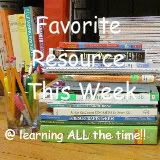A typical week in our homeschool is very busy as in many others out there. We aim to have our daily school completed by lunch-time and reserve the afternoon for field trips, sports, hobbies and friends. When we first began homeschooling we participated in many field trips and quickly became overwhelmed with activities which made it difficult to fit in "school". This general plan helps tremendously.
Last year we attempted to finish school by lunch, but rarely did. This year a few changes made all the difference. First of all there is a rule that the kids need to start school for the day as soon as they wake-up. Last year they always waited for me. After preparing breakfast, starting the laundry and everything else we usually didn't get started until around 9:00. Starting school upon waking works well since they both have activities they do on their own, with each other and with me. Now some days they are finished by 10:30 am depending on how early they rise.
Each kid has their own weekly to-do list. The items listed in blue they can do either together or mostly on their own. Here is what a typical week looks like.
3rd Grader
| Minutes | Days per Week | Subject |
| 15 | 5 | Read to Mom |
| 15 | 5 | Listen to Mom Read |
| 30 | 2 | Silent Reading Books |
| 15 | 5 | Writing |
| 15 | 5 | Spelling |
| 15 | 5 | Mother goose |
| 30 | 5 | Math |
| 30 | 2 | Science Experiment |
| 30 | 2 | German Kids Television |
| 30 | 3 | Rosetta Stone - German |
| 15 | 2 | Silent Reading - German Book |
| 30 | 5 | Spanish Kids Television |
| 15 | 3 | Piano |
| 15 | 3 | Geography Puzzle |
| 60 | 1 | Finish missed work or special movie |
5th Grader
| Time | Days per Week | Subject |
| 15 | 5 | Read to Mom |
| 15 | 5 | Listen to Mom Read |
| 30 | 2 | Silent Reading Books |
| 15 | 5 | Writing |
| 15 | 5 | Spelling |
| 15 | 5 | Poetry |
| 30 | 5 | Math |
| 30 | 2 | Science Experiment |
| 30 | 2 | German Kids Television |
| 15 | 5 | Write a Sentence in German |
| 15 | 2 | Silent Reading - German Book |
| 30 | 5 | Spanish Kids Television |
| 15 | 3 | Violin |
| 15 | 3 | Piano |
| 60 | 1 | Finish missed work or special movie |
In addition to the items listed above the children play outside daily a minimum of 20 minutes per day. During this time they like to play monkey-in-the-middle, or other very physical games with my husband if he is available, or play in the creek behind our house and explore nature. We listen to folk songs and classical music in the car and during meals. Finally, famous works of art are displayed every two weeks following a short discussion of the piece.
Afternoons
Monday - history, crafts and socialization with our weekly History Co-op Group
Tuesday - music lessons
Wednesday - sports, free-time and socialization
Thursday - sports, free-time and socialization
Friday - sports, free-time and socialization
I am linking this post to The Homeschooling Hearts and Mind Blog which is hosting a virtual curriculum fair. Here is the list of posts from other blogging homeschooling families and how they schedule their time.
Weekly Homeschooling Schedule by Julie @ HighHill Homeschool
Virtual Curriculum Fair: Week 5: The Nuts & Bolts: Pulling it all Together by Leah @ The Courtney Six Homeschool
Our Schedule's Working! by Eunora @ All Things NoriLynn
Homeschooling: How do I do it all? by Debbie @ Debbie's Digest
Virtual Curriculum Fair--- Wrap-up Angie @ Petra School
Virtual Curriculum Fair: 5 Ways to Use an iPad in Your Homeschool by Pam @ Everyday Snapshots
A Peek Into Our School Day by Melissa @ Grace Christian Homeschool
A Day in the Life... by Nicole @ Schooling in the Sun
Homeschool and Life: How we get it done by Jen @ Forever, For Always, No Matter What
Homeschooling at My House by Jessica @ Modest Mama
Getting a Grip on Things by Susan @ Homeschooling Hearts & Minds
Making Home School a part of LIFE by Cindy @ For One Another
Now Where's That Pencil Again? by Beth @ Ozark Ramblings
Something About Homeschooling I Really Didn't See Coming by Letha @ justpitchingmytent
Curriculum, Kids, and a Frazzled Homeschool Mama leads to Controlled Chaos! by Laura O from AK @ Day by Day in Our World
The Virtual Curriculum Fair – Nuts and Bolts by Kristen @ Sunrise to Sunset
Staying on Top of Everything by Brenda Emmett @ Garden of Learning
How Does This Homeschooling Thing Actually Work? Fitting it all Together by Joelle @ Homeschooling for His Glory
Nuts & Bolts: Pulling it all together by Christa Darr @ Fairfield Corner Academy








.JPG)





.JPG)
.JPG)
.JPG)
.JPG)









.JPG)
.JPG)
.JPG)
.JPG)
